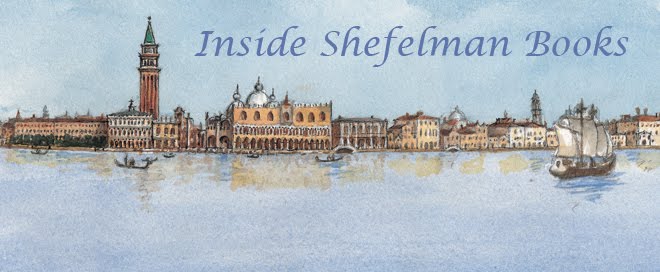JANICE: Tom's illustrations for our picture book biography, I, Papa Haydn, are now finished and sent to the publisher in Seoul. Since it will be published in Korean, you may never see the cover with an English title like this one — but you might. Hopefully an American publisher will buy the foreign rights because we need to keep up with those Koreans!
And here is the full wraparound cover painting. It shows Haydn performing for his patron, Prince Esterhazy, at his summer palace in Hungary. We visited this palace on a cold winter's day and found it closed. If you want to know how we managed to get in, see "Research Adventure," posted here on January 24, 2010. Tom took photographs of the Music Salon where Haydn and his orchestra performed for the prince, his family, and friends.
 The illustration below shows Papa Haydn and his orchestra performing the "Farewell Symphony" in the Music Salon. One year Prince Esterhazy stayed so long in his palace that summer turned into fall. The musicians, who were not allowed to bring their families, were anxious to return home to Vienna. One of them asked "Papa" Haydn to tell the Prince it was time to go back. Haydn said, "A servant does not tell his prince what to do. But maybe I can think of a way to hint." And he did — with music.
The illustration below shows Papa Haydn and his orchestra performing the "Farewell Symphony" in the Music Salon. One year Prince Esterhazy stayed so long in his palace that summer turned into fall. The musicians, who were not allowed to bring their families, were anxious to return home to Vienna. One of them asked "Papa" Haydn to tell the Prince it was time to go back. Haydn said, "A servant does not tell his prince what to do. But maybe I can think of a way to hint." And he did — with music.
He composed the "Farewell Symphony," and the orchestra performed it. One by one each musician's part ended. He blew out his candle, tucked his instrument under his arm and walked out. You can see the man carrying his cello out of the salon to the right, while Prince Esterhazy and his wife look at each other, wondering what is happening. Finally only Haydn was left at the piano and the symphony ended. Prince Esterhazy understood, and the next day they left for Vienna.
And here is the full wraparound cover painting. It shows Haydn performing for his patron, Prince Esterhazy, at his summer palace in Hungary. We visited this palace on a cold winter's day and found it closed. If you want to know how we managed to get in, see "Research Adventure," posted here on January 24, 2010. Tom took photographs of the Music Salon where Haydn and his orchestra performed for the prince, his family, and friends.
 The illustration below shows Papa Haydn and his orchestra performing the "Farewell Symphony" in the Music Salon. One year Prince Esterhazy stayed so long in his palace that summer turned into fall. The musicians, who were not allowed to bring their families, were anxious to return home to Vienna. One of them asked "Papa" Haydn to tell the Prince it was time to go back. Haydn said, "A servant does not tell his prince what to do. But maybe I can think of a way to hint." And he did — with music.
The illustration below shows Papa Haydn and his orchestra performing the "Farewell Symphony" in the Music Salon. One year Prince Esterhazy stayed so long in his palace that summer turned into fall. The musicians, who were not allowed to bring their families, were anxious to return home to Vienna. One of them asked "Papa" Haydn to tell the Prince it was time to go back. Haydn said, "A servant does not tell his prince what to do. But maybe I can think of a way to hint." And he did — with music.He composed the "Farewell Symphony," and the orchestra performed it. One by one each musician's part ended. He blew out his candle, tucked his instrument under his arm and walked out. You can see the man carrying his cello out of the salon to the right, while Prince Esterhazy and his wife look at each other, wondering what is happening. Finally only Haydn was left at the piano and the symphony ended. Prince Esterhazy understood, and the next day they left for Vienna.


-1.jpg)

























